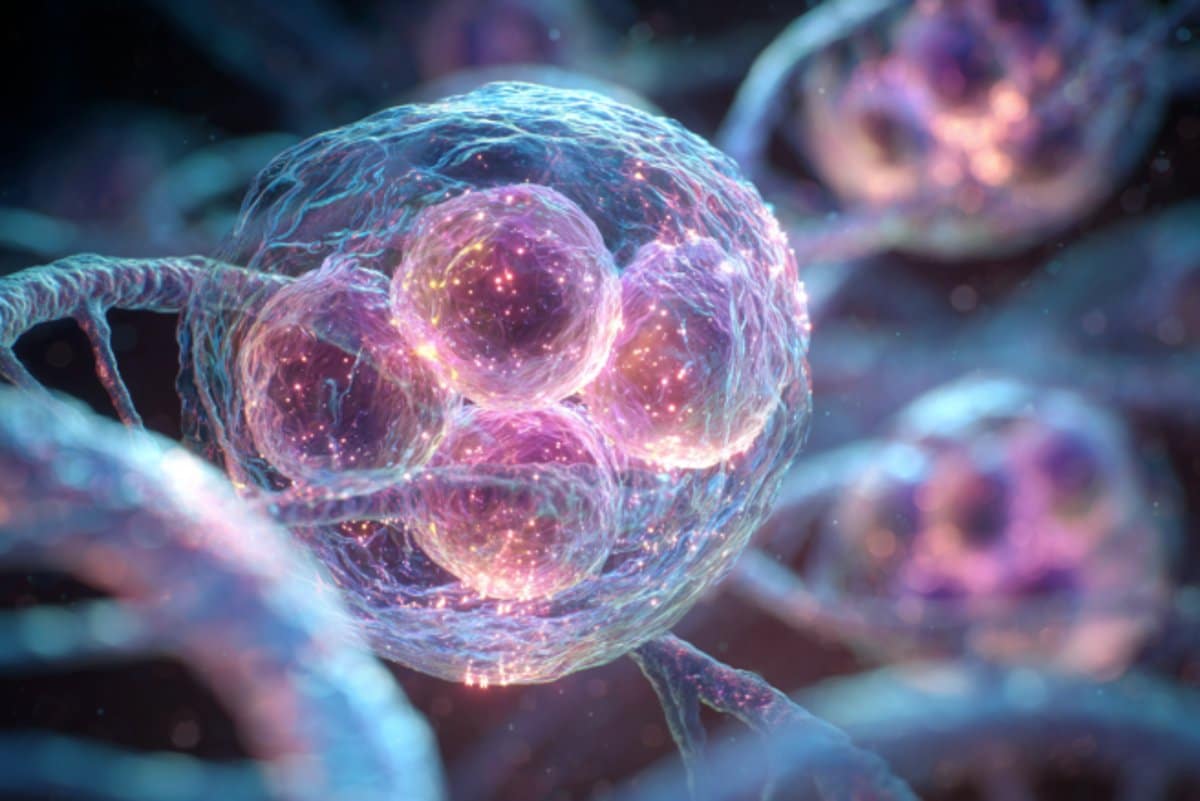Summary: A groundbreaking study reveals that reshaping nuclear speckles — tiny structures inside cell nuclei that regulate protein maintenance — could be a novel way to treat proteinopathies like Alzheimer’s, Parkinson’s, and prion diseases. Researchers found that pyrvinium pamoate, an existing FDA-approved drug, alters the surface tension of nuclear speckles, making them less round and more effective at supporting proteostasis.
In neurons and animal models of tauopathy, the drug dramatically reduced toxic protein accumulation and improved movement and cellular health. The work represents a new frontier in neurodegenerative research, with plans to move toward human clinical trials.
Key Facts:
- Novel Mechanism: Pyrvinium pamoate works by lowering nuclear speckle surface tension, improving protein maintenance across hundreds of genes.
- Strong Results: The drug reduced tau protein buildup by ~70% and improved symptoms in fly and retinal disease models.
- Broad Potential: Could target multiple protein-related disorders, from Alzheimer’s to retinitis pigmentosa.
Source: University of Pittsburgh
Targeting cellular structures called nuclear speckles could be a completely new approach for treating proteinopathies — diseases driven by abnormal accumulation of misfolded proteins — such as Alzheimer’s, Parkinson’s and prion diseases, according to new research publishing in Nature Communications led by the University of Pittsburgh.
“Our research is painting a picture where dysregulation of nuclear speckles is important for neuron degeneration in the context of many diseases,” said senior author Bokai Zhu, Ph.D., assistant professor in Pitt’s Department of Medicine and the Aging Institute.

“The concept of rejuvenating nuclear speckles to treat these diseases is completely novel, but I believe it’s the next frontier of neurodegenerative research.”
Nuclear speckles are structures within cell nuclei that regulate proper protein production, folding and degradation — a balance known as proteostasis. Zhu’s previous research found that nuclear speckle shape affects function: more spherical speckles were linked with worse proteostasis than irregularly shaped ones.
Hypothesizing that drugs that make nuclear speckles less round could treat proteinopathies, Zhu’s team screened hundreds of FDA-approved drugs. When they measured the effects on nuclear speckle sphericity, one stood out: pyrvinium pamoate, originally approved for treating pinworm infections.
And sure enough, pyrvinium pamoate improved proteostasis within cells in a dish, found first author William Dion, Ph.D., a former graduate student in Zhu’s lab.
“We were thrilled that our hypothesis was correct,” said Zhu. “This led us to ask: Does this drug work in disease models, and how does it work?”
Promising Disease Model Results
Zhu collaborated with Xu Chen, Ph.D., at UC San Diego, who studies tauopathies — diseases driven by tau protein buildup in the brain, causing memory, cognitive and locomotive deficits.
In mouse neurons expressing human tau, pyrvinium pamoate reduced the pathological protein by about 70%.
“Tau is a really difficult protein to degrade, so I didn’t think this experiment was going to work,” said Zhu. “But a week after starting my collaboration with Dr. Chen, I got a text message from her saying that she had collected some of the best data in her career.”
Human neurons carrying a frontotemporal dementia-associated tau mutation had abnormally shaped nuclear speckles and elevated tau levels. Led by Yuren Tao, a graduate student in Dr. Xu Chen’s lab, the researchers showed that low doses of the drug restored nuclear speckle shape and dramatically reduced tau levels without causing cellular stress or toxicity.
In fly models of tauopathy, locomotive symptoms can be measured by assessing climbing ability. Adding pyrvinium pamoate greatly improved climbing prowess in both larvae and adult flies — important evidence of the drug’s effectiveness in living creatures.
In experiments led by Yuanyuan Chen, Ph.D., assistant professor of ophthalmology at Pitt, the researchers used mouse retinas cultured in a dish to show that the drug held promise for treating retinitis pigmentosa, a disease caused by a faulty gene that leads to misfolding of the retinal protein rhodopsin, which clogs up the rod cells of the eye and causes progressive vision loss.
Unique Mechanism of Action
To understand how the drug works, Bennett Van Houten, Ph.D., professor in the Pitt Department of Pharmacology & Chemical Biology, led experiments with optical tweezers, which use lasers to precisely manipulate microscopic structures. Nuclear speckles were typically difficult to stretch because of high surface tension, but adding the drug dramatically lowered surface tension, making speckles easy to stretch and rupture.
According to Zhu, when nuclear speckles have lower surface tension, they become less round and spread out to make better contact with chromosomes, leading to greater production of genes regulating proteostasis.
“This was the killer experiment,” said Zhu. “Unlike most drugs, which target a specific receptor, pyrvinium pamoate acts by changing the surface tension of nuclear speckles. This is a totally new idea. Because nuclear speckles act globally on chromosomes, the drug can potentially alter the expression of hundreds of genes — which may be why it is so effective.”
Zhu hopes to move this research into clinical trials soon to test whether pyrvinium pamoate could effectively treat proteinopathies in humans.
Other authors on the study were Shanshan Zhao, Ph.D., Yuhang Nie, M.S., all of UC San Diego; and Maci Chambers, Riley K. Arbuckle, Michelle Sun, Syeda Kubra, Ph.D., Matthew A. Schaich, Ph.D., Megan Ye, Imran Jamal, Ph.D., Mads B. Larsen, Ph.D., Daniel Camarco, M.S., Eleanor Ickes, Haokun H. Wang, M.S., C. DuPont, Bingjie Wang, Ph.D., Silvia Liu, Ph.D., Shaohua Pi, Ph.D., Bill B. Chen, Ph.D., all of Pitt and UPMC.
About this neurodegeneration research news
Author: Anastasia Gorelova
Source: University of Pittsburgh
Contact: Anastasia Gorelova – University of Pittsburgh
Image: The image is credited to Neuroscience News
Original Research: Open access.
“SON-dependent nuclear speckle rehabilitation alleviates proteinopathies” by Bokai Zhu et al. Nature Communications
Abstract
SON-dependent nuclear speckle rehabilitation alleviates proteinopathies
Current treatments targeting individual protein quality control pathways have limited efficacy in alleviating proteinopathies, highlighting the prerequisite for a common druggable target capable of global proteostasis modulation.
Building upon our prior research establishing nuclear speckles as pivotal membrane-less organelles for transcriptional control of proteostasis, we aim to alleviate proteinopathies through nuclear speckle rehabilitation.
We identify pyrvinium pamoate as a nuclear speckle rehabilitator that enhances protein quality control gene expression and suppresses YAP1 transcriptional activity via decreasing the surface/interfacial tension of nuclear speckle condensates through interaction with the intrinsically disordered region of nuclear speckle scaffold protein SON.
In pre-clinical models, nanomolar pyrvinium pamoate protects against retinal degeneration and tauopathy mainly by promoting autophagy and ubiquitin-proteasome activity in a SON-dependent manner without causing stress.
Aberrant nuclear speckle morphology, reduced protein quality control and increased YAP1 activity are observed in human tauopathies.
Our study provides proof-of-principle of targeting nuclear speckles to ameliorate proteinopathies.






